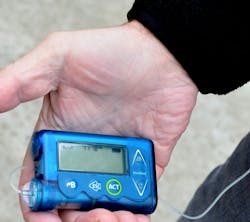In large and racially diverse study of American children and adolescents with type 1 and type 2 diabetes, researchers at Johns Hopkins Medicine, Baylor College of Medicine, and the University of Wisconsin have identified the clinical and demographic factors associated with pediatric diabetic retinopathy, according to a news release from Johns Hopkins.
The disorder, a leading cause of vision loss worldwide, is characterized by damage to the small blood vessels lining the retina (the eye’s light-focusing area).
The researchers say the most important finding from the study — posted online in JAMA Network Open — is that insulin pump users among those with type 1 diabetes are less likely to develop diabetic retinopathy, independent of other risk factors, compared with youth who get their insulin through multiple daily injections.
“We knew from previous studies that insulin pump use is associated with better glycemic control [management of blood sugar level] and lower hemoglobin A1c level [HbA1c is the amount of sugar attached to hemoglobin in red blood cells and a measure of blood sugar level], so we expected that it also would be associated with a reduced risk of complications from diabetes, such as diabetic retinopathy,” says study co-senior author Risa Wolf, MD, Pediatric Endocrinologist and Assistant Professor of Pediatrics at the Johns Hopkins University School of Medicine. “What surprised us was that insulin pump users appear to be more ‘protected’ against retinopathy regardless of their A1c levels.”
To get their results, the researchers at the three participating institutions looked at 1,640 children and adolescents with either type 1 (74%) or type 2 (26%) diabetes. The average age was nearly 16 years old, with females making up 53% of the group. There was a diverse mix of races and ethnicities: 40% non-Hispanic white, 31% Hispanic, 23% non-Hispanic Black and 6% other (American Indian or Alaska Native, Asian, Native Hawaiian or Pacific Islander, and unspecified or undeclared).
Overall, 558 of 1,216 patients (46%) with type 1 diabetes and five of 416 patients (1.2%) with type 2 diabetes used an insulin pump. Diabetic retinopathy was found in 57 of the total 1,640 participants, or 3.5%.
The one disparity that remained after controlling for other factors was insulin pump use. "Pump users were more likely to be White [59%, compared with 27% of Black youth] and have private or commercial insurance,” says Wolf.

